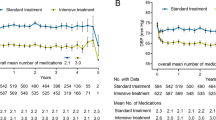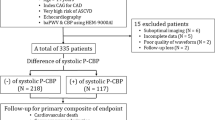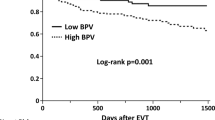Abstract
Individual shear rate therapy (ISRT) evolved from external counterpulsation with individual treatment pressures based on Doppler ultrasound measurements. In this study, we assessed the effect of ISRT on blood pressure (BP) in patients with coronary artery disease (CAD). Eighty-four patients with symptomatic CAD were included in the study. Forty-one patients were enrolled for 6 weeks, comprising 30 sessions of ISRT; 43 age- and sex-matched patients represented the control group. The 24-h BP was determined by measuring the pulse transit time before and after 6 weeks of ISRT or the time-matched control. Participants were divided into three groups according to the 24-h BP before treatment: BP1 < 130/80 mmHg (normotensive); BP2 ≥ 130–140/80 mmHg (moderate hypertensive); BP3 > 140/80 mmHg (hypertensive). After 30 sessions of ISRT, the 24-h BP decreased significantly, whereas no changes were observed in the controls. The BP-lowering effect correlated with the 24-h BP before therapy (systolic: r = −0.78; p < 0.001; diastolic: r = −0.76; p < 0.001). In BP1, the systolic BP decreased by 4.3 ± 6.4 mmHg (p = 0.011), and the diastolic BP decreased by 4.8 ± 11.0 mmHg (p = 0.032); in BP2, the systolic BP decreased by 13.3 ± 7.5 mmHg (p < 0.001), and the diastolic BP decreased by 5.0 ± 7.5 mmHg (p = 0.002); and in BP3, the systolic BP decreased by 22.9 ± 11.4 mmHg (p < 0.001), and the diastolic BP decreased by 9.1 ± 9.5 mmHg (p = 0.003). Our findings demonstrate that ISRT reduces BP in patients with CAD. The higher the initial BP the greater the lowering effect.
This is a preview of subscription content, access via your institution
Access options
Subscribe to this journal
Receive 12 print issues and online access
$259.00 per year
only $21.58 per issue
Buy this article
- Purchase on Springer Link
- Instant access to full article PDF
Prices may be subject to local taxes which are calculated during checkout




Similar content being viewed by others
References
Lopez AD, Mathers CD, Ezzati M, Jamison DT, Murray CJ. Global and regional burden of disease and risk factors 2001: systematic analysis of population health data. Lancet. 2006;367:1747–57.
Henry TD, Satran D, Jolicoeur EM. Treatment of refractory angina in patients not suitable for revascularization. Nat Rev Cardiol. 2014;11:78–95.
Montalescot G, Sechtem U, Achenbach S, Andreotti F, Arden C, Budaj A, et al. 2013 ESC guidelines on the management of stable coronary artery disease: the taskforce on the management of stable coronary artery disease of the European society of cardiology. Eur Heart J. 2013;34:2949–3003.
Buschmann EE, Brix M, Li L, Doreen J, Zietzer A, Li M, et al. Adaption of external counterpulsation based on individual shear rate therapy improves endothelial function and claudication distance in peripheral artery disease. Vasa. 2016;45:317–24.
Gurovich AN, Braith RW. Enhanced external counterpulsation creates acute blood flow patterns responsible for improved flow-mediated dilation in humans. Hypertension Res. 2013;36:297–305.
Sharma U, Ramsey H, Tak T. The role of enhanced external counter pulsation therapy in clinical practice. Clin Med Res. 2013;11:226–32.
Braith RW, Conti CR, Nichols WW, Choi CY, Khuddus MA, Beck DT, et al. Enhanced external counterpulsation improves peripheral artery flow mediated dilation in patients with chronic angina: a randomized sham-controlled study. Circulation. 2010;122:1612–20.
Sardina PD, Martin JS, Avery JC, Braith RW. Enhanced external counterpulsation improves biomarkers of glycemic control in patients with non-insulin-dependent type II diabetes mellitus for up to 3 months following treatment. Acta Diabetol. 2016;53:745–75.
Buschmann I, Pries A, Styp-Rekowska B, Hillmeister P, Loufrani L, Henrion D, et al. Pulsatile shear and Gja5 modulate arterial identity and remodeling events during flow-driven arteriogenesis. Development. 2010;137:2187–96.
Picard F, Panagiotidou P, Wolf-Pütz A, Buschmann I, Buschmann E, Steffen M, et al. Usefulness of individual shear rate therapy, new treatment option for patients with symptomatic coronary artery disease. Am J Cardiol. 2018;121:416–22.
Campbell AR, Satran D, Zenovich AG, Campbell KM, Espel JC, Arndt TL, et al. Enhanced external blood counterpulsation improves systolic blood pressure in patients with refractory angina. Am Heart J. 2008;156:1217–22.
Bondesson S, Pettersson T, Ohlsson O, Hallberg IR, Wackenfors A, Edvinsson L. Effects on blood pressure in patients with refractory angina pectoris after enhanced external counterpulsation. Blood Press. 2010;19:287–94.
Casey DP, Beck DT, Nichols WW, Conti CR, Choi CY, Khuddus MA, et al. Effects of enhanced external counterpulsation arterial stiffness and myocardial oxygen demand in patients with chronic angina pectoris. Am J Cardiol. 2011;10:1466–72.
May O, Khair WA. Enhanced external counterpulsation has no lasting effect on ambulatory blood pressure. Clin Cardiol. 2013;36:21–24.
Bilo G, Zorzi C, Ochoa Munera JE, Torlasco C, Giuli V, Parati G. Validation of the Somnotouch-NIBP noninvasive continuous blood pressure monitor according to the European Society of Hypertension International Protocol revision 2010. Blood Press Monit. 2015;20:291–4.
Bartsch S, Ostojic D, Schmalgemeier H, Bitter T, Westerheide N, Eckert S, et al. Validierung der kontinuierlichen nicht-invasiven Blutdruckmessung mittels Puls-Transit-Zeit. Dtsch medizinische Wochenschr. 2010;135:2406–12.
Eckert S. 100 Jahre Blutdruckmessung nach Riva-Rocci und Korotkoff: Rückblick und Ausblick. Austrian J Hypertension. 2006;10:7–13.
Bonetti PO, Holmes DR, Lerman A, Barsness GW. Enhanced external counter pulsation for ischemic heart disease: whats behind the curtain? J Am Coll Cardiol. 2003;41:1918–25.
Lin W, Xion L, Han J, Leung T, Soo Y, Chen X, et al. External counter pulsation augments blood pressure and cerebral flow velocities in ischemic stroke patients with cerebral intracranial large artery occlusive disease. AHA J Stroke. 2012;43:300–1.
Abbottsmith CW, Chung ES, Varricchione T, de Lame PA, Silver MA, Francis GS, et al. Enhanced external counter pulsation improves exercise duration and peak oxygen consumption in older patients with heart failure: a subgroup analysis of the PEECH Trial. Congestive heart fail. 2006;12:307–11.
Mancia G, Fagard R, Narkiewicz K, Redón J, Zanchetti A, Böhm M. 2013 ESH/ESC guidelines for the management of arterial hypertension: the task force for the management of arterial hypertension of the European Society of Hypertension (ESH) and of the European Society of Cardiology (ESC). Eur Heart J. 2013;34:2159–219.
Vlachopoulos C, Aznaouridis K, O'Rourke MF, Safar ME, Baou K, Stefanadis C. Prediction of cardiovascular events and all-cause mortality with central haemodynamics: a systematic review and meta-analysis. Eur Heart J. 2010;31:1865–71.
Vidal-Petiot E, Ford I, Greenlaw N, Ferrari R, Fox KM, Tardif JC, et al. Cardiovascular event rates and mortality according to achieved systolic and diastolic blood pressure in patients with stable coronary artery disease: an international cohort study. Lancet. 2016;388:2142–252.
Ettehad D, Emdin CA, Kiran A, Anderson S, Callender T, Emberson J, et al. Blood pressure lowering for prevention of cardiovascular disease and death: a systematic review and meta-analysis. Lancet. 2016;387:957–67.
Mancia G, Schumacher H, Redon J, Verdecchia P, Schmieder R, Jennings G, et al. Blood pressure targets recommended by guidelines and incidence of cardiovascular and renal events in the ongoing telmisartan alone and in combination with Ramipril global endpoint trial. Circulation. 2011;124:1727–36.
Sundström J, Arima H, Jackson R, Turnbull F, Rahimi K, Chalmers J, et al. Blood pressure lowering treatment based on cardiovascular risk: a meta-analysis of individual patient data. Lancet. 2014;384:591–98.
Beck DT, Casey DP, Martin JS, Sadina PW, Braith RW. Enhanced external counterpulsation reduces indices of central blood pressure and myocardial oxygen demand in patients with left ventricular dysfunction. Clin Exp Pharmocol Physiolol. 2015;42:315–20.
Sardari A, Hosseini S, Bozorgi A, Lotfi-Tokaldany M, Sadeghian H, Nejatian M. Effects on enhanced external counterpulsation on heart rate recovery in patients with coronary artery disease. J Tehran heart Cent. 2018;13 Suppl 1 :13–17.
Wei W, Jin H, Chen ZW, Zioncheck TF, Yim AP, He GW. Vascular endothelial growth factor-induced nitric oxide- and PGI2-dependent relaxation in human internal mammary arteries: a comparative study with KDR and Flt-1 selective mutants. J Cardiovasc Pharm. 2004;44:615–21.
Acknowledgements
We thank Claudia Stelzmann and Xenia Monreal, who provided help during the research, and we thank the patients who supported this study.
Author information
Authors and Affiliations
Corresponding author
Ethics declarations
Conflict of interest
The authors declare that they have no conflict of interest.
Additional information
Publisher’s note Springer Nature remains neutral with regard to jurisdictional claims in published maps and institutional affiliations.
Rights and permissions
About this article
Cite this article
Picard, F., Panagiotidou, P., Wolf-Pütz, A. et al. Individual shear rate therapy (ISRT)—further development of external counterpulsation for decreasing blood pressure in patients with symptomatic coronary artery disease (CAD). Hypertens Res 43, 186–196 (2020). https://doi.org/10.1038/s41440-019-0380-x
Received:
Revised:
Accepted:
Published:
Issue Date:
DOI: https://doi.org/10.1038/s41440-019-0380-x
Keywords
This article is cited by
-
May need more comprehensive approach to residual risks in well controlled hypertensive patients
Hypertension Research (2021)



